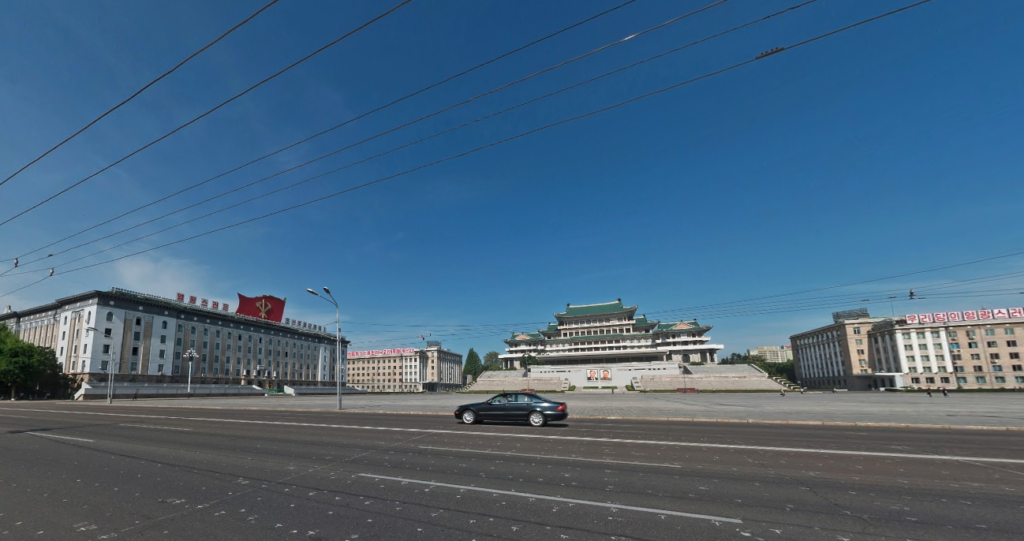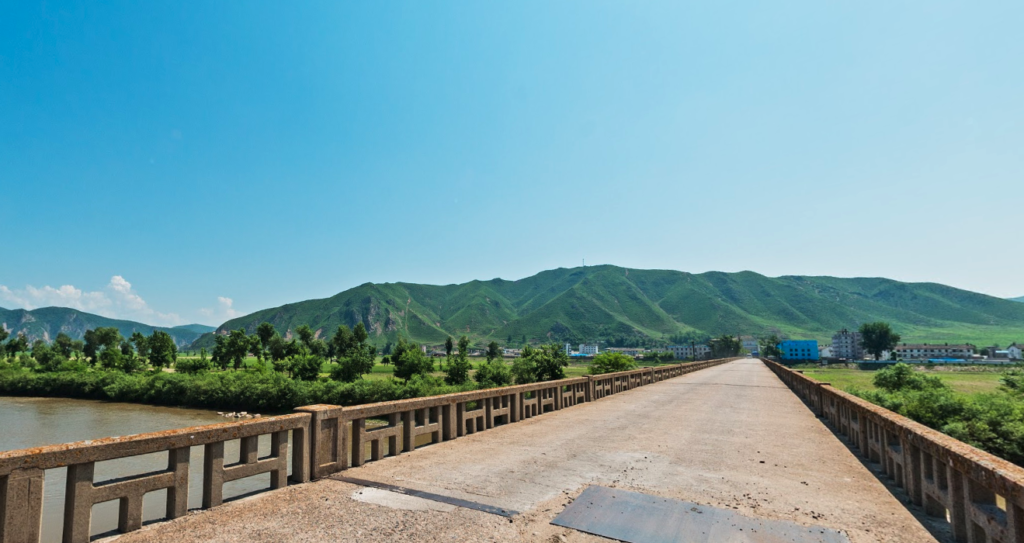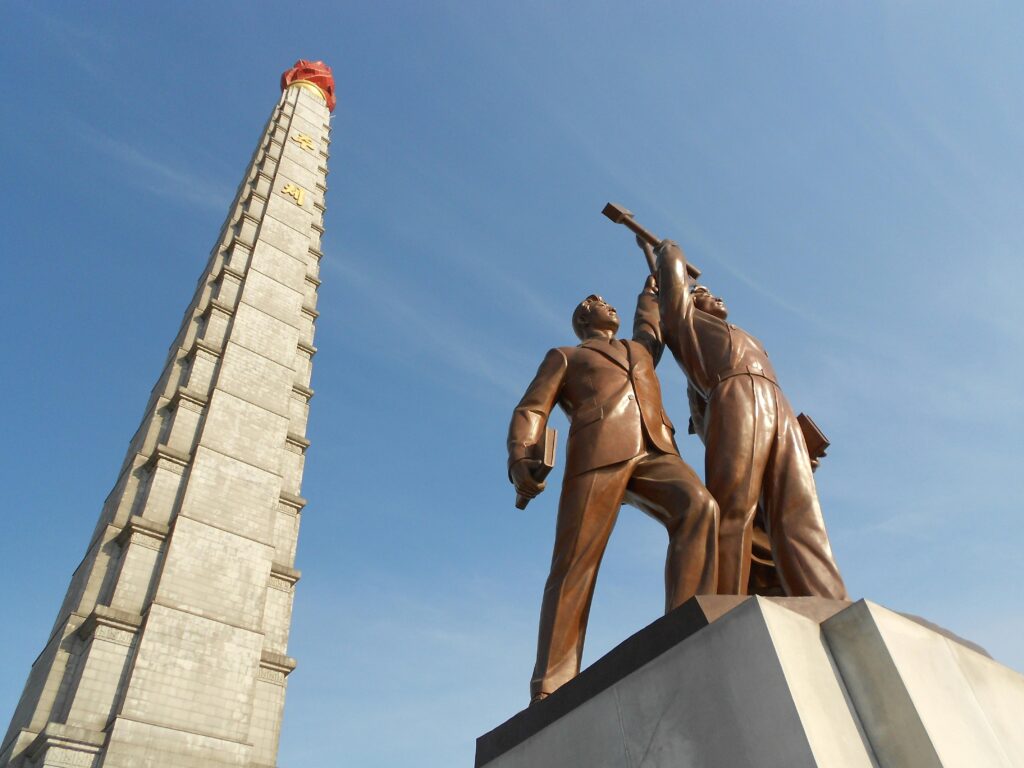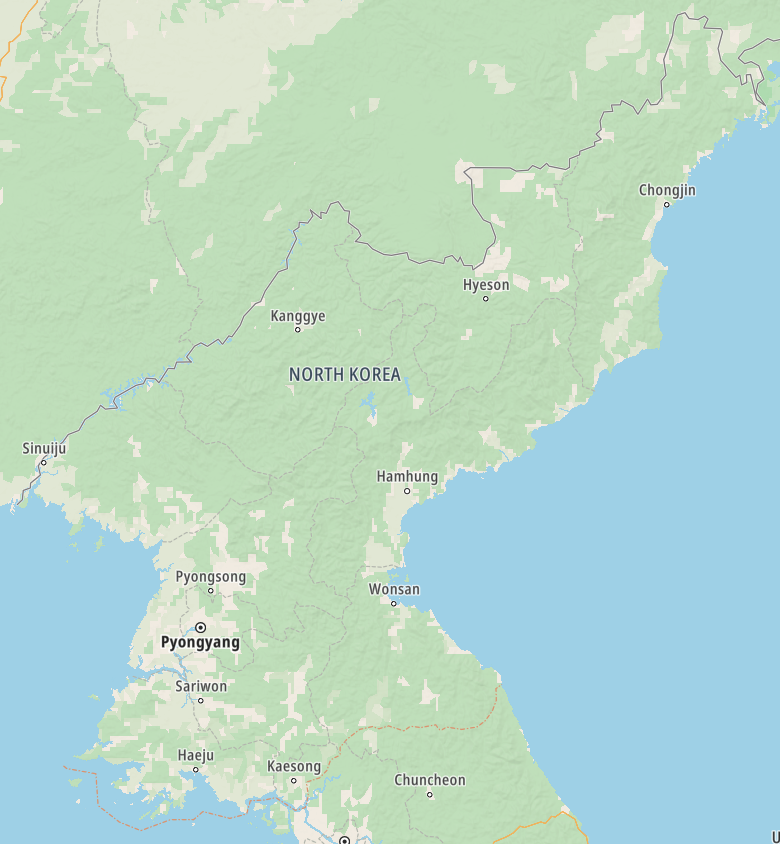North Korea / 조선민주주의인민공화국 / Chosŏn Minjujuŭi Inmin Konghwaguk – Let’s explore here

What’s it like in North Korea?
North Korea is a mountainous country in east Asia on the Korean Peninsula. At about half the size of the UK, the country is dominated by forested mountains that cover 80% of the land. The highest point is the volcano, Paektu Mountain, in the north east of the country near the border with China, at 9,020 ft (2,750 m) above sea level.
The majority of the population of around 26 million people (2024), live on the plains, including about three million who live in the capital, Pyongyang.
It has a very long, rich and troubled history. Its neighbours include China, Russia and South Korea, the latter of which it is separated from by the Korean Demilitarized Zone.
Life in North Korea is highly controlled and shaped by the country’s government, which is led by the ruling Kim family under the ideology of Juche, a form of self-reliance. The country has a highly centralised and authoritarian political system, and everyday life is influenced by this regime. The government exercises strict control over nearly every aspect of people’s lives, including their access to information, movements and activities. The regime limits access to the outside world by blocking international media, websites and foreign communications. Citizens are not allowed to freely travel abroad, and foreigners visiting the country face strict limitations on where they can go and what they can do.


A bit about the history of North Korea
Ancient Korea
The history of Korea dates back to prehistoric times, with early evidence of human settlement dating as far back as the Lower Paleolithic period. The first historically recorded Korean kingdom was Gojoseon, founded around 2333 BC. This was followed by the rise of the Three Kingdoms of Korea: Goguryeo, Baekje, and Silla, which coexisted and frequently fought for dominance on the Korean Peninsula from the 1st century BC to the 7th century AD.
The Three Kingdoms Period
During the Three Kingdoms Period, the three kingdoms developed distinct cultures, languages, and political systems. Goguryeo was the largest and most powerful of the three, while Baekje and Silla were located in the southern parts of the peninsula. The kingdoms experienced frequent conflicts, with Silla eventually uniting the peninsula under its rule in 668 AD after defeating Baekje and Goguryeo with help from Tang China.
Unified Silla and Goryeo Dynasties
The Unified Silla period (668-935 AD) marked a period of relative peace and prosperity. Silla established a centralised government, built major cultural and architectural achievements, and saw the spread of Buddhism throughout the region. However, by the 9th century, internal strife weakened the Silla kingdom.
In 935, the Goryeo dynasty was founded by Wang Geon, which ruled from 918 to 1392. The Goryeo dynasty succeeded Silla, and its government continued many of the administrative practices established by Silla. It was during this time that the name ‘Korea’ was derived from the name of the dynasty. The Goryeo period is also known for the creation of the Tripitaka Koreana, one of the most complete collections of Buddhist scriptures in the world, and the invention of the movable metal type printing press.
Joseon Dynasty
The Joseon dynasty (1392-1897) was established by Yi Seong-gye, who became King Taejo. This period saw the rise of Confucianism as the dominant state ideology, which shaped Korean society, culture, and governance. The Joseon dynasty is considered one of the most influential periods in Korean history, during which the Korean language, Hangul, was created in the 15th century by King Sejong the Great. This era also saw cultural achievements such as the creation of Korean painting, ceramics and literature. The Joseon dynasty faced several invasions, including the Japanese invasions of the late 16th century (Imjin War) and the Manchu invasions in the 17th century. Despite these challenges, the dynasty remained in power until the late 19th century.
Japanese Colonial Period
Korea was annexed by Japan in 1910 after decades of increasing Japanese influence in the region. The Japanese colonial period (1910-1945) was marked by exploitation, suppression of Korean culture, and harsh control over the population. During this time, Japan sought to integrate Korea into its empire, imposing Japanese language and culture while also exploiting Korea’s resources for Japan’s benefit. Resistance to Japanese rule, such as the March 1st Movement in 1919, was met with violent repression. Korea remained under Japanese control until the end of World War II in 1945.
Division of Korea
After Japan’s defeat in World War II, Korea was liberated from Japanese rule. However, the peninsula was divided into two occupation zones along the 38th parallel by the Allies, with the Soviet Union taking control of the north and the United States taking control of the south. This division led to the creation of two separate Korean states: North Korea and South Korea.
The Korean War
In 1950, the Korean War broke out when North Korean forces, under Kim Il-sung, invaded South Korea. The United Nations, led by the United States, intervened on behalf of South Korea, while China and the Soviet Union supported North Korea. The war ended in 1953 with an armistice agreement, but no peace treaty was signed, leaving the two Koreas in a state of ongoing tension and division. The Korean War caused immense destruction and loss of life, with millions of people killed, wounded or displaced.
Post-War Period and Kim Il-sung’s Rule
Following the Korean War, Kim Il-sung established a totalitarian regime in the North, consolidating power with the help of the Soviet Union. Kim introduced the ideology of Juche, or self-reliance, and began to develop a cult of personality around himself. The regime pursued a policy of isolationism, building a strong military while limiting economic ties to the outside world. During Kim Il-sung’s rule, the country focused on heavy industry and collectivised agriculture, but the economy was often inefficient and struggled with food shortages.
The Korean Demilitarized Zone
After the Korean War, the Korean Demilitarised Zone (DMZ) was established along the 38th parallel as a buffer zone between North and South Korea. The DMZ remains one of the most heavily militarised borders in the world. Despite the armistice, tensions between the two Koreas persist, and both sides continue to maintain large military forces along the border.
The Kim Family Dynasty
The leadership of North Korea has remained in the hands of the Kim family. Kim Il-sung ruled until his death in 1994, at which point his son, Kim Jong-il, took power. Kim Jong-il’s reign was marked by a continuation of his father’s policies of isolation and military buildup. Under Kim Jong-il, North Korea pursued nuclear weapons development, which further isolated the country from the international community and led to sanctions.
The Rise of Kim Jong-un
Kim Jong-il died in 2011, and his son, Kim Jong-un, assumed leadership of North Korea. Kim Jong-un’s rise to power was initially met with scepticism due to his youth and inexperience, but he quickly solidified his control over the country. His leadership has been characterised by continued nuclear weapons testing, further repression of political opposition, and a focus on maintaining the regime’s power.
Modern Era
The division of Korea remains to this day, with both Korean nations maintaining their separate governments, ideologies and military forces. In recent years, North Korea has made international headlines for its nuclear weapons tests and missile launches. These actions have led to increased tensions with the United States and South Korea, as well as international sanctions.
The relationship between the two Koreas has fluctuated between conflict and attempts at reconciliation. South Korea became a democratic and economic powerhouse, while North Korea remained isolated under the rule of the Kim family. In recent decades, there have been periods of diplomatic engagement, including summits between the leaders of North and South Korea, but the issue of North Korea’s nuclear weapons program remains a major point of tension.


North Korea road trip
We haven’t finished our planning for our road trip through North Korea yet. When we do though, we’ll post it here, and in the blog.
Hopefully our journey will improve our knowledge of this intriguing and beautiful country, and enable us to meet some interesting people. We’ll be updating this page at that time – don’t forget to check back 🙂
Map of North Korea

What’s it like to drive in North Korea?
They drive on the right hand side of the road in North Korea. In the main, roads in cities are very good, however more rural roads are very poor.
Do you require an international driving permit in North Korea?
International driving permits are not valid in North Korea. Travel for visitors within North Korea is severely restricted, and you will require a guide to accompany you. The guide will decide where you can go, and it is their responsibility to get permission to travel outside Pyongyang. Military checkpoints on entry and exit to all towns usually include ID checks.
Can you use your UK driving license when driving through North Korea?
We’ve created a dedicated page to driving abroad, which answers this question, and more, which you might find helpful.
Do I need a carnet de passages to drive in North Korea?
We’ve created a dedicated page to driving abroad, which answers this question, and more, which you might find helpful.
Can you use public transport in North Korea?
Foreign nationals are not usually allowed to use public transport unless they are accompanied by a local guide. You can get a taxi from hotels or outside some department stores, however taxi drivers will be reluctant to take you without a local guide or interpreter.
What currency do they use in North Korea?
In North Korea they use the North Korean won. Although as a tourist there are only two places you can use the won, and both are in Pyongyang – the Kwangbok Department Store and the Daesong Department Store. US Dollars, the Euro and the Chinese Renminbi are widely accepted. Cash is widely used. The use of credit / debit cards is not accepted. Travellers cheques are not accepted. There are ATMs in some cities throughout the country, although they do not accept foreign-issued cards.
You should make yourself aware of the amount that your bank charges you for using credit and debit cards abroad. Often credit cards are cheaper for purchasing items directly, and for withdrawing cash from ATMs.
What language do they speak in North Korea?
They speak Korean in North Korea. English is not spoken.
What time zone is North Korea in?
Remember, when you’re planning your next trip to take a look at what time zone it’s in.
Do I need a visa to visit North Korea?
We’ve created a dedicated, more comprehensive page on visas, which you should find helpful. Check it out!
Is wild camping legal in North Korea?
No, wild camping is illegal in North Korea.
What plug / socket type do they use in North Korea?
In North Korea they use plug / socket types A and C.


Health issues in North Korea
Is it safe to drink water in North Korea?
No, it is not safe to drink tap water in North Korea. Bottled water is readily available throughout the country.
What vaccinations are required for North Korea?
This NHS website is kept up to date with all relevant information on vaccinations in North Korea.
Phones in North Korea
What is the country calling code for North Korea?
The country calling code for North Korea is +850
What are the emergency phone numbers in North Korea?
- The emergency number for police in North Korea is: 119
- In North Korea, the emergency number for ambulance is: 119
- The emergency number for fire in North Korea is: 119
If you’ve got some useful info that you’d like to share, let us know!
And don’t forget to check out all the other pictures!
